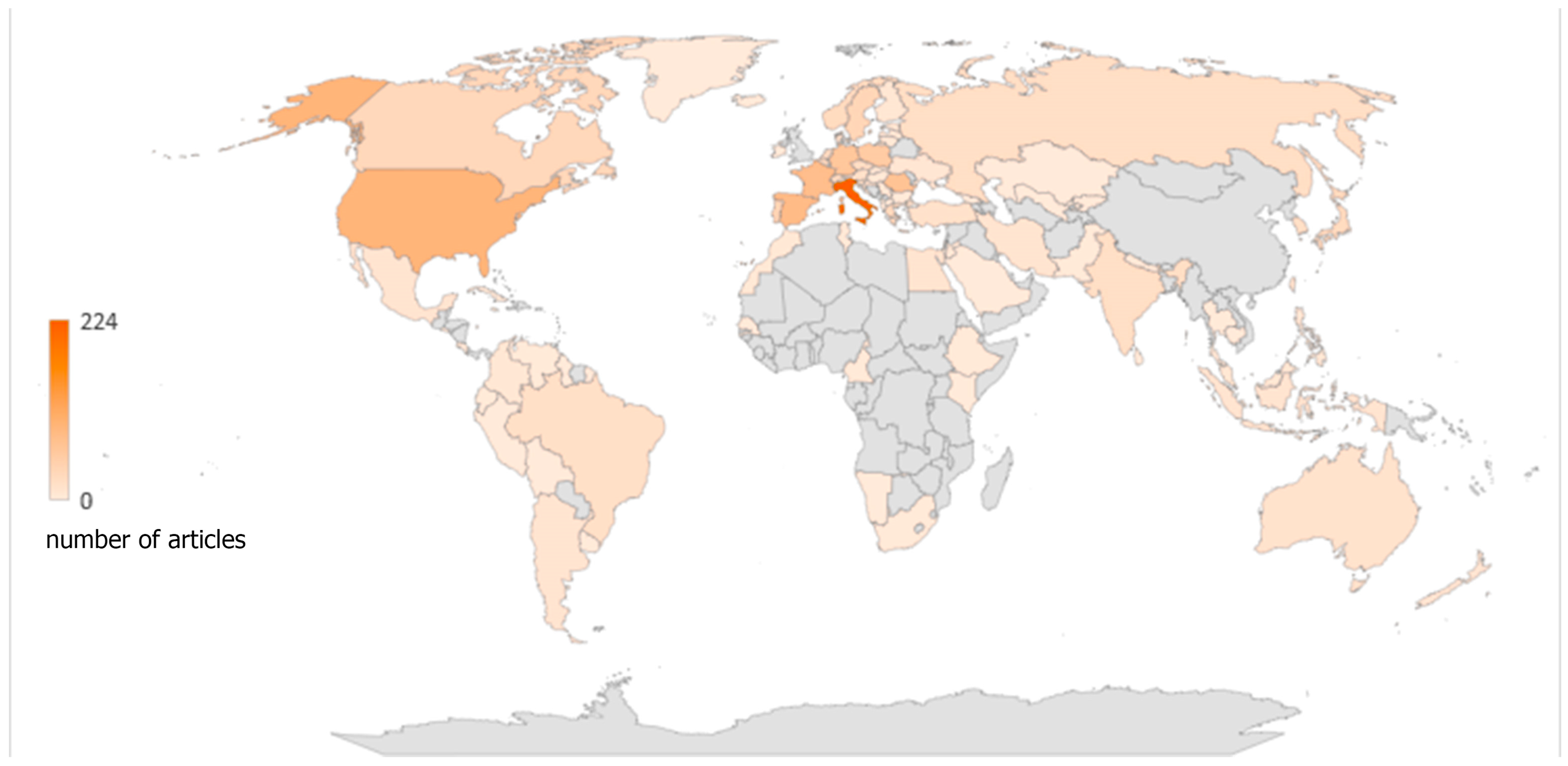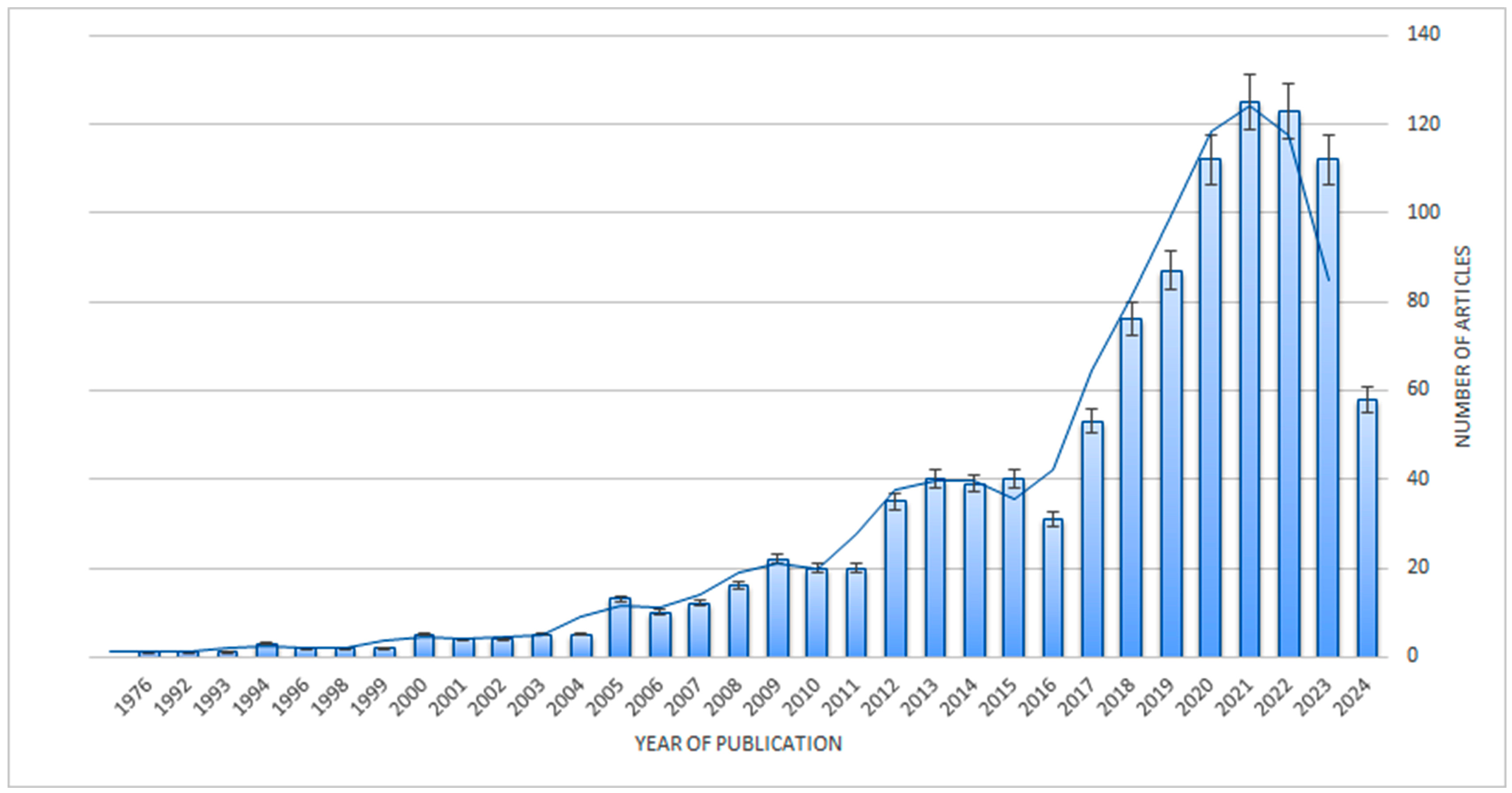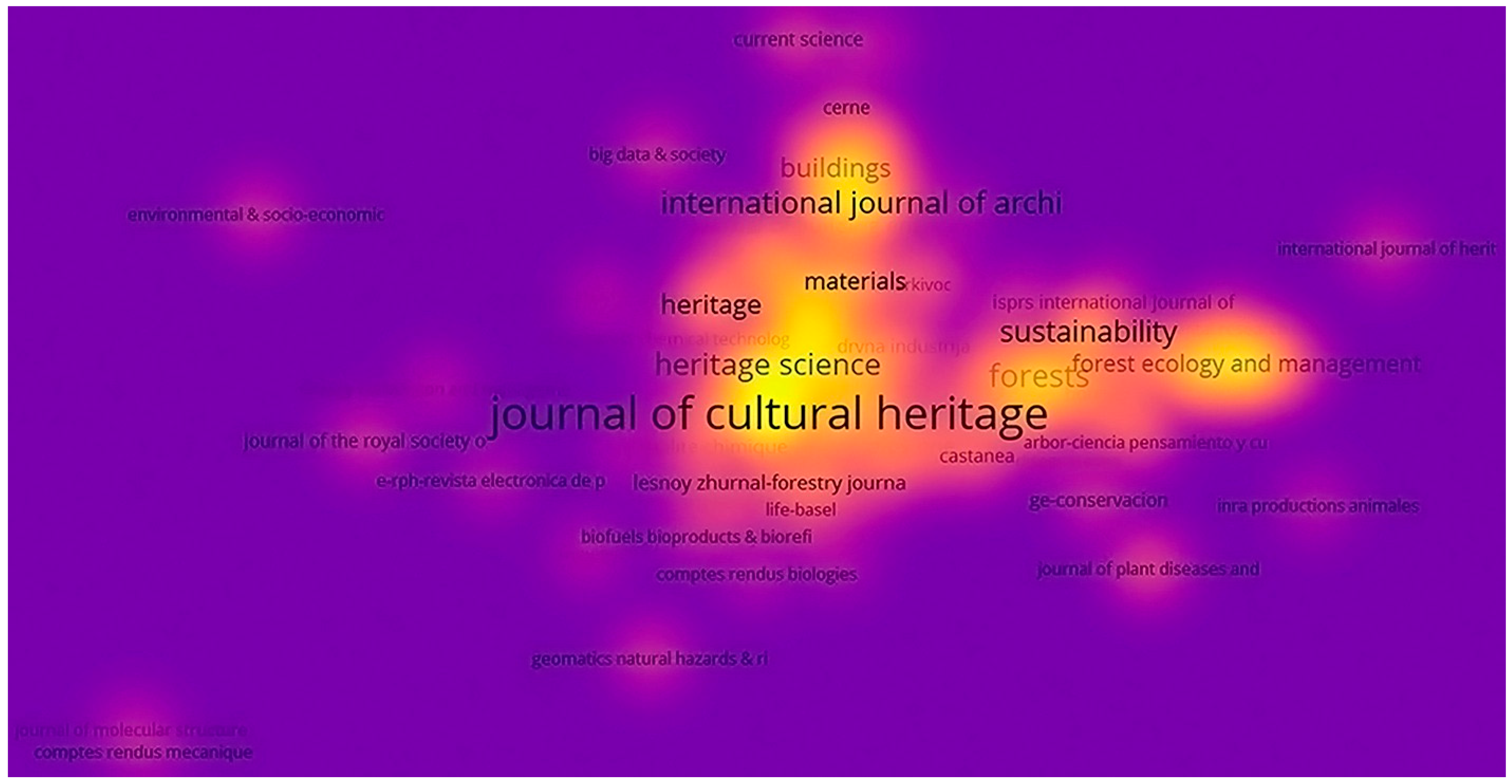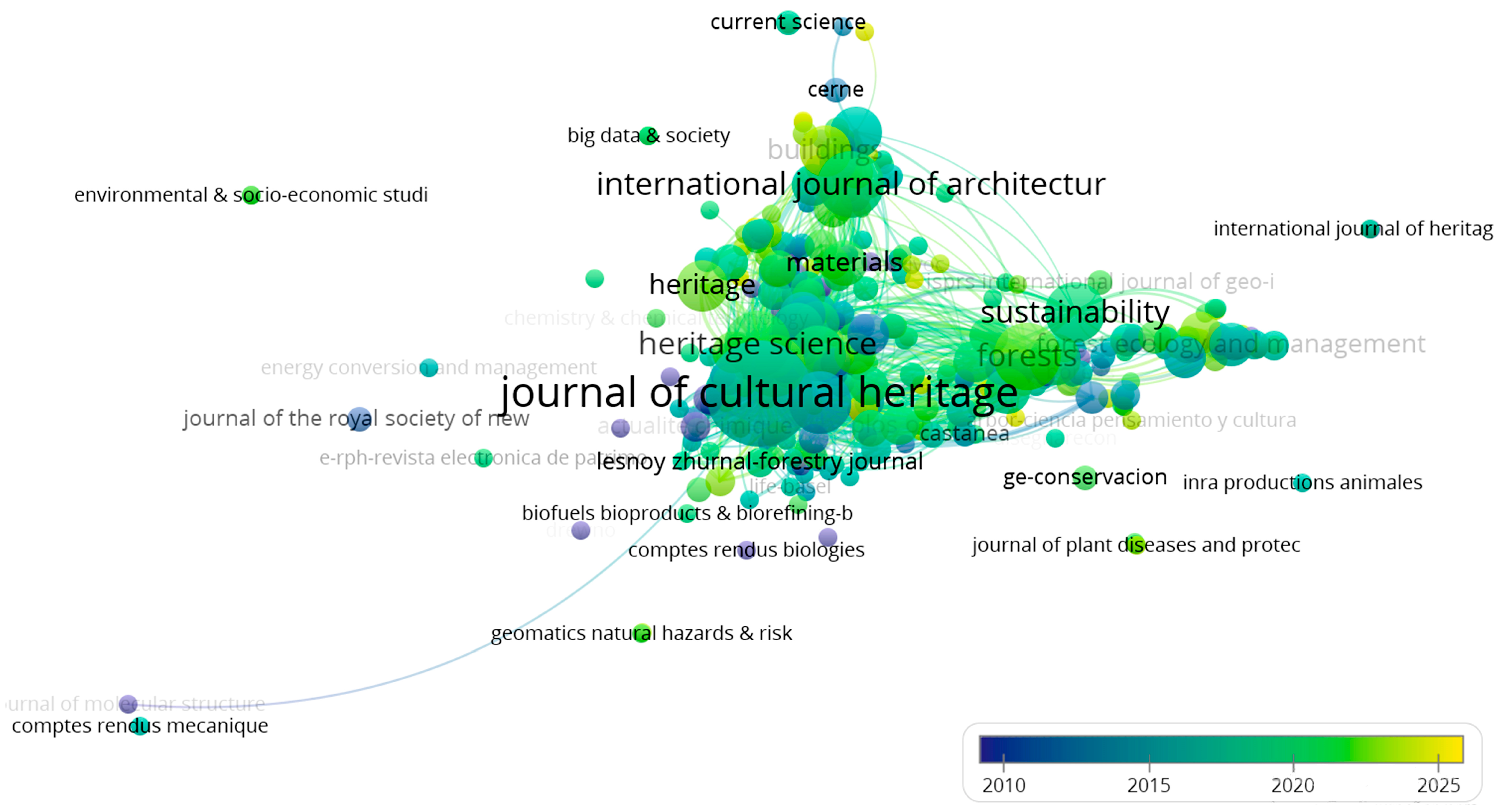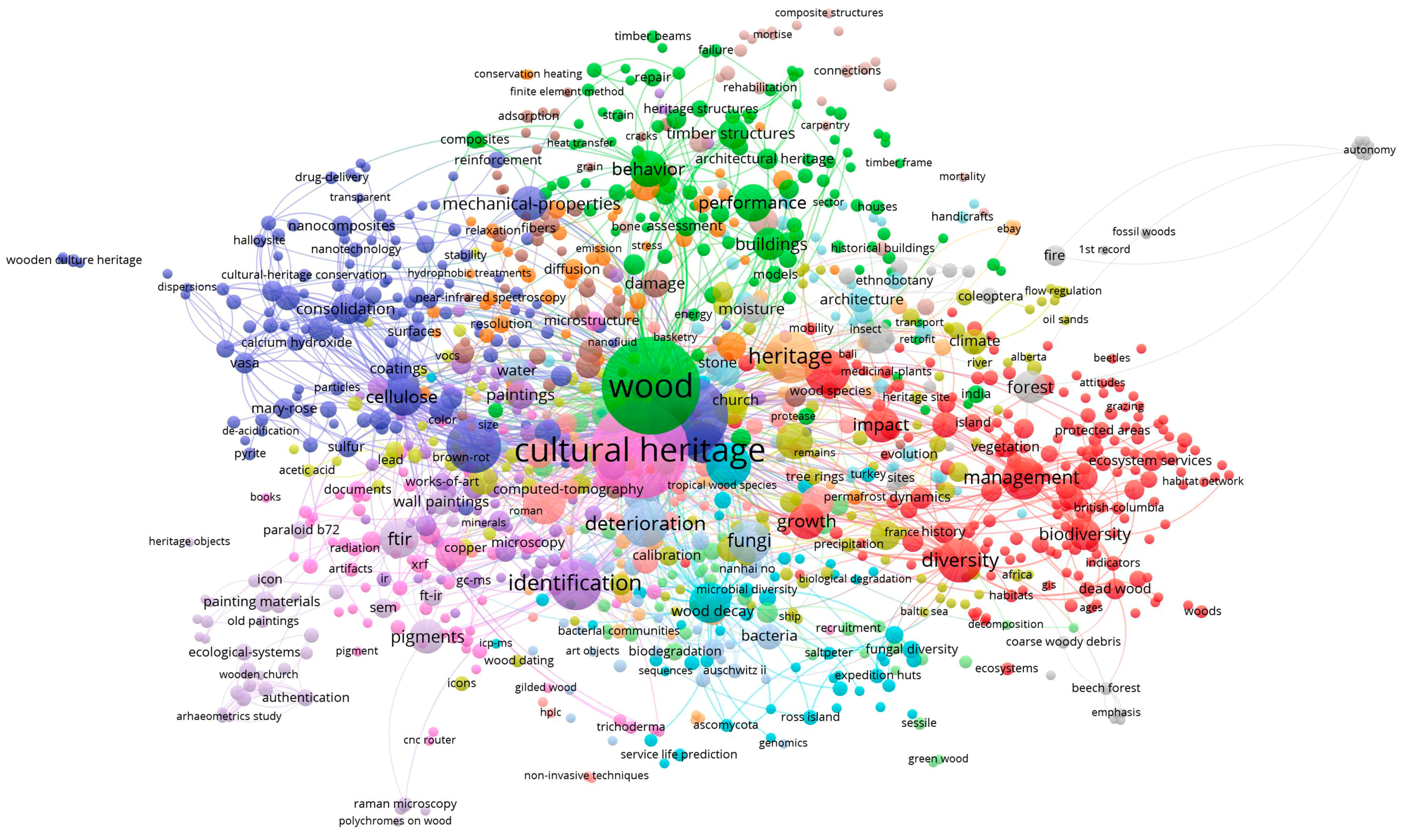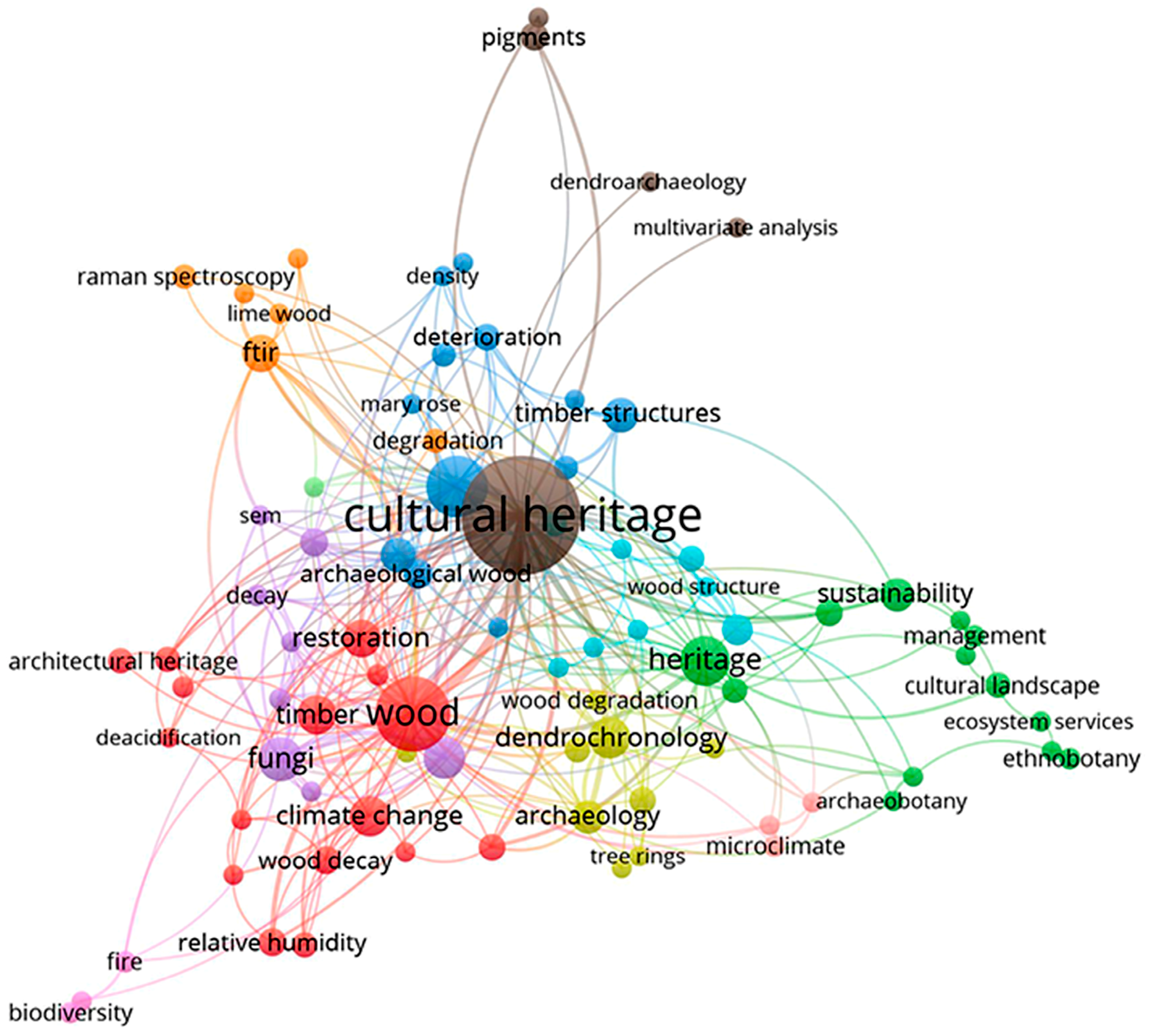1. Introduction
Wood has accompanied the development of nearly all human cultures worldwide; this is demonstrated by countless types of artefacts that have come to us and are now recognised as part of our cultural heritage. The intrinsic relationship between human societies and wood is evidenced by the diverse uses of various tree species [
1], among the more than 60,000 species cataloged in nature [
2,
3]. This use results in a wide range of cultural artefacts produced to address aspects related to the symbolic world, health, survival, subsistence, warfare, and social interaction, which characterize the way of life, traditions, beliefs, and cultural expressions built by human societies over time and across regions of the globe [
4].
Thus, wood is considered one of the most important renewable raw materials worldwide [
5] and the most widely used resource by human cultures [
1], having been used for thousands of years [
6]. Wood is a biodegradable material, so not many wooden artefacts have survived, despite its use by humans since the most distant antiquity. The earliest examples start with the ancient Egyptians, due their very dry conservation environment [
7]. Otherwise, we must rely heavily on the illustrations and descriptions from the past. However, we still need to start from a time relatively close to us in the long evolutionary history of humans.
Understanding that much of the material culture produced by human societies stems from using wood as a raw material helps us grasp the symbolic and actual significance of the relationship between human groups and forests. This understanding also aids in mapping the memories, knowledge, and practices related to culturally significant trees. Trees and wood are essential components of biodiversity and are crucial for many human groups’ survival. They serve as a central resource that supports the functionality of their ways of life and the continuation of their practices and cultural expressions.
Given this context, studies on the cultural heritage of wood have attracted the interest of researchers from various scientific fields and have increased significantly over the past few decades. But what exactly constitutes wood cultural heritage? By applying UNESCO’s definition of Cultural Heritage to wooden artefacts, the following definition can be proposed: Wooden Cultural Heritage includes wooden artefacts that have a diversity of values, including symbolic, artistic, aesthetic, ethnological or anthropological, scientific, and social significance.
The study of wood used in cultural heritage should focus on artefacts with significant historical–cultural and collective value, grounded in primordial ancestry or knowledge resulting from the fusion of teachings from historically interconnected human cultures [
8]. Such studies also allow for exploring questions about cultural history, forms of organisation, technological skills of human societies over time, and their nature management practices [
6]. They can signal pathways that point to adopting global biodiversity conservation strategies in light of the current scenario of anthropogenic forest erosion and climate change, which may be responsible for the decline of rich cultural expressions and ancestral knowledge related to wood.
In this context, it is rather challenging to organise, summarise, and conduct a practical quantitative analysis of the development of a specific field amidst a vast number of studies spanning a long period using traditional reviews [
9]. The cultural use of wood is an interdisciplinary research object encompassing disciplines such as botany, ecology, environmental science, forest engineering, civil engineering, architecture, history, geography, museology, conservation, and restoration.
Bibliometric and scientometric tools can effectively describe the status of knowledge, characteristics, and trends within a specific field or discipline [
9] and are commonly used in scientific research [
10]. Scientometrics enables the measurement of the “power” and “prestige” of countries, regions, universities, and research centres, providing a detailed view of the evolution and decline of various scientific fields [
11,
12,
13]. Using techniques from computer engineering and statistical analyses, it allows for a precise observation of the boundaries of a topic or research field through data mining from publications indexed in various databases [
14]. It also helps identify high-quality research groups [
15] and aids researchers in understanding the evolutionary path of research [
16] from large volumes of scientific data [
17]. The consistency of analytical indicators appears to be satisfactory with a minimum of 50 articles [
18], but databases containing 1000 articles have been demonstrated to provide highly robust results [
19]. The application of scientometrics is not limited to developed countries; it is also crucial for developing nations to distribute their scientific support funds efficiently.
The main objective of this paper is to provide an overview of the main trends regarding studies on the cultural use of wood using bibliometric and scientometric methods derived from the Web of Science (WoS) databases. To achieve this objective, the following topics will be considered: (1) essential characteristics of the literature, such as the number of articles and citations, research subject categories, and representative journals; (2) research power in this area, such as countries, institutions, and representative authors; (3) research topics and trends in the evolution of research hotspots over time; (4) opportunities for future research.
This study is grounded in the hypothesis that the interdisciplinary exploration of the cultural use of wood reveals critical insights into human history, ecological interactions, and cultural practices. By analysing bibliometric and scientometric data, we aim to uncover patterns that illustrate the prominence of this field, its key contributors, and the potential for its integration into contemporary challenges, such as biodiversity conservation, cultural preservation, and climate change mitigation.
The paper seeks to investigate the gaps and connections between disciplines, emphasising the importance of preserving the material artefacts and intangible heritage associated with the cultural use of wood and traditional forestry practices. It believes that consolidating data capable of synthesising the field are crucial for prospecting new studies that will expand the understanding of the role of wood in the constitution of cultural heritage on a global scale.
3. Results
Table 2 presents key information about the articles on the cultural use of wood mined from the WoS database. The analysed metadata revealed 1079 articles published between 1976 and 2024 in 200 scientific journals indexed in the WoS database. Of this total, 93.23% are original research articles, while 6.77% are review articles. This literature review involved 4089 authors and generated 5484 keywords and 11,408 cited references. In total, 91 countries are represented in the publications.
Table 2.
Principal statistical information of the collection of 1079 original and review articles related to the cultural use of wood, published in the WoS database between 1976 and 2024.
Table 2.
Principal statistical information of the collection of 1079 original and review articles related to the cultural use of wood, published in the WoS database between 1976 and 2024.
| Category | Value |
|---|
| Original articles | 1006 |
| Review articles | 73 |
| Period | 1976–2024 |
| Countries | 91 |
| Scientific journals | 200 |
| Number of WoS categories | 140 |
| Number of disciplines | 90 |
| Number of authors | 4089 |
| Number of keywords | 5484 |
3.1. Countries
The analysis of countries’ contributions to scientific publications revealed a sizeable geographical diversity and an intense concentration of publications in some countries, with many nations contributing on a smaller scale (
Figure 1). The countries with the highest number of publications are mainly from Europe, Asia, and North America, with Italy (224), China (99), and the USA (93) standing out, followed by Spain (81), France (78), and England (71). These countries are responsible for most publications, reflecting their research tradition on the topic.
Figure 1.
Countries’ contribution to the bibliographic production on the cultural use of wood, from 1976 to 2024, as indexed in the WoS.
Figure 1.
Countries’ contribution to the bibliographic production on the cultural use of wood, from 1976 to 2024, as indexed in the WoS.
Northern European countries, such as Sweden (35), Norway (27), and the Netherlands (24), also make considerable contributions, although on a smaller scale. On the other hand, countries like Brazil (19), South Africa (3), Egypt (11), Colombia (6), and Malaysia (6) reflect a lower contribution to the total number of publications, which may be related to the late interest of researchers from the global south in the topic. Emerging and developing countries, such as India (21), Russia (21), Turkey (16), Argentina (10), Mexico (10), and Indonesia (10), have shown growing contributions in recent years, although still at lower volumes compared to traditional scientific powerhouses. The group of countries with only one publication (such as Albania, Barbados, Cambodia, El Salvador, Georgia, among others) reflects a very marginal participation in global scientific publications on the cultural use of wood.
3.2. International Collaborations
A visualisation of the international collaboration network among 46 countries that published at least five articles is shown in
Figure 2. Each node represents a country, with the size of the nodes proportional to the number of publications, and the thickness of the lines between nodes reflecting the intensity of collaboration between partner countries. Italy, China, and the USA are prominent contributors to the collaboration network. Eight clusters (coded by different colors) were formed based on the collaboration among these partner countries. The pink cluster is led by Italy, which collaborates with 34 countries, notably the USA, France, Spain, China, and Romania. The green cluster is primarily formed based on collaboration between China, Mexico, and Belgium. The yellow cluster is formed mainly by collaboration between France and Spain, and it also includes countries such as Argentina, Greece, and India to a lesser extent. The lilac cluster encompasses collaboration among countries from various continents, with prominent countries like Canada, the Czech Republic, Russia, and the Republic of Korea. England leads the red cluster, which collaborates with the Netherlands, Brazil, and Colombia. The collaboration between Germany and Cameroon leads the orange cluster. The light blue cluster represents the collaboration between Sweden, Ukraine, and Poland. The remaining clusters involve fewer countries in collaboration.
Figure 2.
International collaboration among countries that published articles on the cultural use of wood from 1976 to 2024. The size of the circles is proportional to the number of publications, while the thickness of the lines reflects the intensity of collaboration between countries.
Figure 2.
International collaboration among countries that published articles on the cultural use of wood from 1976 to 2024. The size of the circles is proportional to the number of publications, while the thickness of the lines reflects the intensity of collaboration between countries.
3.3. Disciplines
The articles are related to one or more research categories from the WoS, totaling 140 distinct categories or thematic areas of research publication. The top ten categories include materials science (7.5%), analytical chemistry (7.0%), archaeology (5.6%), spectroscopy (5.3%), geosciences (5.0%), art (4.4%), forestry science (4.4%), construction technology (4.3%), civil engineering (4.2%), and environmental sciences (3.8%). The least represented categories are telecommunications, sports science, soil science, and political science, each contributing 0.04%.
A total of 91 disciplines or areas of knowledge were recorded, with the top ten being represented by chemistry (251 papers), materials science (243 papers), engineering (171 papers), environmental science (135 papers), archaeology (133 papers), spectroscopy (124 papers), geology (120 papers), art (104 papers), and forestry science (104 papers). The disciplines with the least contribution were telecommunications, sports science, psychology, and philosophy, each with only one paper published (
Figure 3).
Figure 3.
Contribution of disciplines to the bibliographic production on the cultural use of wood, from 1976 to 2024, in the WoS database.
Figure 3.
Contribution of disciplines to the bibliographic production on the cultural use of wood, from 1976 to 2024, in the WoS database.
3.4. Trends over Time
An evolution in the number of articles published on the cultural use of wood between 1976 and 2024 was observed, with a significant increase over the past few decades, particularly from 2010 onwards (
Figure 4). The data reveal a substantial growth in the volume of publications in recent years, with peaks in 2021 and 2022, when 125 and 123 articles were recorded, respectively. Since 2019, a steady growth has been observed, reflecting an increasing academic interest in research on wood in cultural, heritage, and environmental contexts. On the other hand, until 2005, the volume of published articles was more modest, with much smaller numbers and less scientific attention.
Figure 4.
Evolution of articles on the cultural use of wood published in the WoS database between 1976 and 2024. The blue line represents the trendline.
Figure 4.
Evolution of articles on the cultural use of wood published in the WoS database between 1976 and 2024. The blue line represents the trendline.
When comparing ten years, it is noted that the average production from 1976 to 1996 was relatively low, totaling only 10 articles over these two decades. From 1997 to 2006, there was a slight increase, with a total of 22 articles, representing a 120% rise. Between 2007 and 2016, the number of publications rose to 240 articles, reflecting a substantial 990% increase compared to the previous period. From 2017 to 2024, there was an even more pronounced growth, with 746 articles, representing a 210.83% increase compared to the last decade, consolidating the topic’s relevance in contemporary scientific research. Considering the total period of 48 years, the average annual production was 22.47 articles per year.
3.5. Languages and Journals
The analysis of the distribution of publications by language revealed an overwhelming dominance of English, with 92.08% of the total 1079 publications analysed. The following most frequent languages are Spanish (2.12%) and French (1.38%), both with significantly lower representation, followed by Russian (0.64%), Croatian (0.55%), and other European and Asian languages such as Italian, Portuguese, Turkish, German, Japanese, Polish, and Chinese, each representing between 0.09% and 0.46%. The “unspecified” category accounts for 0.28% of publications, suggesting gaps in categorising publication languages. In quantitative terms, English stands out as the lingua franca in scientific publications on the cultural use of wood, reflecting its central role in the international research landscape. At the same time, the other languages represent specific niches, with significant variation in publication frequency. Although the other languages represent a smaller portion, they still show diversity in global scientific production (
Figure 5).
Figure 5.
Distribution of publication languages of articles on the cultural use of wood published in the WOS database between 1976 and 2024.
Figure 5.
Distribution of publication languages of articles on the cultural use of wood published in the WOS database between 1976 and 2024.
The total number of journals identified was 200, with various titles across different fields of knowledge, ranging from heritage science to environmental and physical sciences (
Figure 6). The first journal to dominate this list, with an intense concentration of publications, is the
Journal of Cultural Heritage, with 72 published articles. This title, with the highest number of publications, can be considered a milestone in the development of this thematic field, followed by other highly relevant journals such as
Heritage Science (22 publications) and the
International Journal of Architectural Heritage (22 publications), which also stand out for their interdisciplinary contributions. Other journals, including
Forests (23 publications),
Applied Sciences Basel (19 publications),
Sustainability (18 publications),
Buildings (12 publications),
Dendrochronologia (12 publications), and
Journal of Wood Science (11 publications), show a significant focus on the interaction between environmental sciences and the conservation of natural resources, including culturally substantial woods, supporting the interdependence between cultural heritage and environmental preservation.
Figure 6.
Density map of scientific journals that published articles on the cultural use of wood between 1976 and 2024. The colour variation, from lilac to yellow, indicates an increase in the number of articles published by scientific journals in this direction.
Figure 6.
Density map of scientific journals that published articles on the cultural use of wood between 1976 and 2024. The colour variation, from lilac to yellow, indicates an increase in the number of articles published by scientific journals in this direction.
From a temporal perspective on the contribution of scientific journals, it is evident that, unlike the scenario depicted in the density map, other journals are currently contributing to the communication of research on woods used for cultural purposes, albeit with a smaller number of published articles. More recently, a strong contribution from the journals
Sustainability,
Heritage, and
Forests can be observed, represented in the figure below by the light green and yellow clusters, which are more associated with the last five years (
Figure 7).
Figure 7.
Overlay map of scientific journals from a temporal perspective, showing published articles on the cultural use of wood between 1976 and 2024. Each node represents a scientific journal, and the size of each node is proportional to the number of publications from each journal. Warmer colours indicate journals with more recent publications.
Figure 7.
Overlay map of scientific journals from a temporal perspective, showing published articles on the cultural use of wood between 1976 and 2024. Each node represents a scientific journal, and the size of each node is proportional to the number of publications from each journal. Warmer colours indicate journals with more recent publications.
3.6. Keywords
Of the 5484 keywords used in the articles on the cultural use of wood, a word cloud was formed with the 238 most frequent keywords mined from the general database, which appear at least five times in the collection of publications (
Figure 8). The most important keywords are cultural heritage with 237 occurrences, wood with 171, conservation with 111, degradation with 52, heritage with 49, identification with 47, deterioration with 38, followed by decay, diversity, and timber, each with 36 occurrences. Words such as fungi, with 32 occurrences, biodeterioration, and restoration, each with 29, also appear. Many of the words concern the relationship between the cultural heritage of wooden artefacts and their conservation in the face of degradation processes caused by weathering and decomposing organisms. Thus, the word cloud helps identify the most important research topics.
Figure 8.
Network of all keywords based on the co-occurrence method on the cultural use of wood between 1976 and 2024. Each node represents a keyword, and its size is proportional to the number of publication occurrences. The thickness of the lines between the nodes represents the strength of the relationship between keywords, determined by the frequency with which they appear together in publications.
Figure 8.
Network of all keywords based on the co-occurrence method on the cultural use of wood between 1976 and 2024. Each node represents a keyword, and its size is proportional to the number of publication occurrences. The thickness of the lines between the nodes represents the strength of the relationship between keywords, determined by the frequency with which they appear together in publications.
The connection between cultural heritage, deterioration, and biodeterioration marks the violet cluster. It is also the most expressive regarding the number of words related to one another, showing a strong relationship with cultural heritage degradation. The green cluster establishes a connection between wood, timber, performance, climate changes, buildings, and other words linked to different categories of cultural wooden artefacts, indicating a more environmental perspective associated with wood used for cultural purposes. The blue cluster connects the words degradation, cellulose, and other words related to the chemistry and techniques of wood evaluation and conservation. The red cluster links diversity, biodiversity, management, and impact. The pink cluster stands out with the word identification, relating to the botanical identity of woods. The remaining clusters are less expressive regarding the number of words and their connections.
The authors’ keywords total 3713 words, from which a cloud was formed consisting of the 84 most frequently used keywords by the authors, considering a minimum occurrence of five repetitions of the same word in publications (
Figure 9). The most important keywords in this context are cultural heritage with 166 occurrences, wood with 67, conservation with 45, fungi with 24, heritage with 29, and dendrochronology and biodeterioration with 21 each. The brown cluster features cultural heritage as the most prominent word in the network, connecting with terms like pigments, dendroarchaeology, and multivariate analyses. The green cluster relates to socio-environmental issues, including heritage, management, sustainability, cultural landscape, ecosystem services, and ethnobotany. The red cluster is more connected to conservation, linking words like wood, architectural heritage, restoration, wood decay, and climate change. The other clusters are less significant in terms of word frequency.
Figure 9.
Network of author keywords based on the co-occurrence method on the cultural use of wood from 1976 to 2024. Each node represents a keyword, and its size is proportional to the number of publication occurrences. The thickness of the lines between nodes represents the strength of the relationship between keywords, determined by the frequency with which they appear together in publications.
Figure 9.
Network of author keywords based on the co-occurrence method on the cultural use of wood from 1976 to 2024. Each node represents a keyword, and its size is proportional to the number of publication occurrences. The thickness of the lines between nodes represents the strength of the relationship between keywords, determined by the frequency with which they appear together in publications.
The plus keywords total 2193 words, from which a word cloud was formed with the 140 most frequent words, considering a minimum occurrence of five times the same word in the publications (
Figure 10). The most important plus keywords in this context are wood with 111, conservation with 73, cultural heritage with 71, degradation with 46, identification with 44, decay and diversity with 33 each. The green cluster is related to conservation methods about degradation agents, connecting words like wood, deterioration, climate change, impact, damage, temperature, risk, prediction, and model. The dark blue cluster is linked to wood chemistry, related to words like cellulose, nanoparticles, chemistry, and iron. The red cluster relates to environmental issues, connecting words such as diversity, forests, vegetation, dendrochronology, and management. The yellow cluster appears to be related to physical properties, linking words like density, growth ring, inspection, calibration, and tomography. The other clusters are less expressive, gathering fewer words.
Figure 10.
Network of keywords based on the co-occurrence method on the cultural use of wood from 1976 to 2024. Each node represents a keyword, and its size is proportional to the number of publication occurrences. The thickness of the lines between nodes represents the strength of the relationship between keywords, determined by the frequency with which they appear together in publications.
Figure 10.
Network of keywords based on the co-occurrence method on the cultural use of wood from 1976 to 2024. Each node represents a keyword, and its size is proportional to the number of publication occurrences. The thickness of the lines between nodes represents the strength of the relationship between keywords, determined by the frequency with which they appear together in publications.
3.7. Institutions
The analysis of scientific citations from 1976 to 2024 shows a growing trend, reflecting the impact of research over the decades (
Table 3). The total number of citations increased significantly during this period, with a more pronounced growth starting in 2014. When analysing citations by country, Italy leads the ranking with 3887 citations. Following Italy, Germany, the USA, the UK, Spain, Romania, and France occupy the following positions. Together, the 10 most-cited countries account for 12,824 citations.
Table 3.
The top ten most cited countries, institutions, authors, and articles on the cultural use of wood, based on WoS (1976–2024).
Table 3.
The top ten most cited countries, institutions, authors, and articles on the cultural use of wood, based on WoS (1976–2024).
| N° | Category | Total Articles | (%) * | Total Citations |
|---|
| 1 | Country | Italy | 224 | 30.31 | 3887 |
| 2 | Germany | 56 | 10.53 | 1351 |
| 3 | USA | 81 | 10.32 | 1324 |
| 4 | England | 66 | 9.28 | 1190 |
| 5 | Spain | 75 | 7.85 | 1007 |
| 6 | France | 69 | 7.84 | 1005 |
| 7 | Poland | 74 | 6.96 | 893 |
| 8 | China | 91 | 6.39 | 820 |
| 9 | Sweden | 33 | 5.58 | 715 |
| 10 | Belgium | 22 | 4.93 | 632 |
| 1 | Institution | University of Florence (Italy) | 31 | 27.06 | 883 |
| 2 | University of Ljubljana (Slovenia) | 14 | 10.21 | 333 |
| 3 | CNR (Italy) | 23 | 9.96 | 325 |
| 4 | University of Palermo (Italy) | 14 | 9.04 | 295 |
| 5 | University Oxford (England) | 6 | 9.01 | 294 |
| 6 | University of Copenhagen (Denmark) | 6 | 8.58 | 280 |
| 7 | Sweden University of Agriculture Science (Sweden) | 6 | 7.88 | 257 |
| 8 | University of Minnesota (USA) | 8 | 7.75 | 253 |
| 9 | Polish Academy Science (Poland) | 9 | 5.39 | 176 |
| 10 | Lodz University of Technology (Polska) | 5 | 5.12 | 167 |
| 1 | Article | Plieninger (2015) | | 13.69 | 219 |
| 2 | Bergneier (2010) | | 13.31 | 213 |
| 3 | Haneca (2009) | | 12.13 | 194 |
| 4 | Giorgi (2002) | | 10.50 | 168 |
| 5 | Baglioni (2006) | | 10.38 | 166 |
| 6 | Cruz (2015) | | 8.63 | 138 |
| 7 | Gibson (2010) | | 8.25 | 132 |
| 8 | Domingues (2013) | | 8.13 | 130 |
| 9 | Baglioni (2013) | | 7.81 | 125 |
| 10 | De Filpo (2013) | | 7.19 | 115 |
Among the 1479 institutions that produced articles on the cultural use of wood during the assessed period, only 76 had five or more articles published in the WoS. The ten most productive institutions are listed in
Table 2. The University of Florence leads with 31 articles, representing 27.06% of the total contribution of citations, totaling 883. In second place is the University of Ljubljana, with 14 published articles, contributing 10.21% of the total citations, reaching 333. The National Research Council (CNR) occupies the third position with 23 articles and a 9.96% contribution to the total citations, amounting to 325 citations. The University of Palermo, with 14 articles and a 9.04% contribution, follows closely behind with 295 citations. The University of Oxford, with six published articles, also contributes 9.01% to the total citations, with 294 citations. Other notable institutions include the University of Copenhagen (six articles, 8.58% contribution, 280 citations) and the Swedish University of Agricultural Sciences (six articles, 7.88% contribution, 257 citations). The University of Minnesota, with eight articles and a 7.75% contribution, has 253 citations. The Polish Academy of Sciences, with nine articles and a 5.39% contribution, totals 176 citations. Finally, with five articles and a 5.12% contribution, the Lodz University of Technology reaches 167 citations.
Of the 4098 authors, only 29 have five or more articles published in the WoS. The ten most-cited authors reveal an intense concentration of contributions from Italian researchers. Italy has six authors who contributed 1722 citations, accounting for 61.8% of the total citations in the analysed set, highlighting the centrality of Italian research in the field. Polish authors account for 320 citations, equivalent to 11.5% of the total, with each author publishing five articles. The United States contributes 9.0%, with seven articles published and 251 citations. Germany provides 167 citations, representing 6.79% of the total.
Of the 1079 articles analysed, the most-cited ones accumulated 1620 citations during the period considered. These articles reveal a clear predominance of European studies, with Italy and Germany occupying the top positions. A 2015 German-authored article leads the list, closely followed by another German study from 2010. Together, these articles account for 27.00% of the citations. Italian contributions are significant, with articles published in 2002, 2006, and twice in 2013, representing 35.88% of the total citations. Belgium also stands out with a 2009 article responsible for 12.13% of the citations. Portugal and the United States contribute 8.63% and 8.25%, respectively. Lastly, Spain accounts for 8.13% of the total citations (
Table 3).
Italian organisations, such as the University of Florence, CNR, and the University of Palermo, lead the collaboration network between institutions. Although they are in distinct clusters, they are the ones that cooperate the most with other institutions (
Figure 11). In general, it can be observed that collaborations occur over small geographical distances, with each cluster often consisting of institutions from the same country or very close neighbours. Italian institutions dominate the blue and green clusters. The red cluster represents a mix of Portuguese, Italian, and Spanish universities. The orange cluster is formed by Asian institutions, and the yellow by Eastern European institutions. A small and isolated brown cluster is formed by a Romanian organisation studying the country’s history.
Figure 11.
Network of international collaboration among institutions that published articles on the cultural use of wood between 1976 and 2024. The size of nodes is proportional to the number of publications, while the thickness of the lines reflects the intensity of collaboration between institutions.
Figure 11.
Network of international collaboration among institutions that published articles on the cultural use of wood between 1976 and 2024. The size of nodes is proportional to the number of publications, while the thickness of the lines reflects the intensity of collaboration between institutions.
3.8. Sustainable Development Goals
Research on culturally used wood is directly related to several Sustainable Development Goals (SDGs), mainly due to the environmental, social, and cultural impacts of forests and wood as a renewable resource. Most publications are related to SDG 15 (Life on Land), with 186 publications; SDG 11 (Sustainable Cities and Communities), with 172 publications; SDG 13 (Climate Action), with 167 publications; and SDG 14 (Life Below Water), with 136 publications. Together, these SDGs account for 661 publications, representing about 62% of all the articles analysed in the period, emphasising the significant role that culturally used wood plays in advancing global sustainability goals (
Figure 12). Research on the cultural use of wood strongly connects with various Sustainable Development Goals (SDGs). Specifically, the focus on wood as a renewable resource and its impact on environmental sustainability and cultural heritage directly contributes to the SDGs, particularly SDGs 15, 11, 13, and 14. SDG 15 (Life on Land) is strongly represented in the literature, highlighting the importance of sustainable forest management and biodiversity conservation, which are central aspects of the cultural use of wood. SDG 11 (Sustainable Cities and Communities) emphasizes integrating preservation techniques into urban planning and cities’ cultural heritage conservation. SDG 13 (Climate Action) addresses the role of wood and forests in mitigating climate change, primarily through carbon sequestration and sustainable forest management practices based on ancestral knowledge. Finally, SDG 14 (Life Below Water) is potentially associated with studies on submerged artefacts and the organisms that interact with them.
Figure 12.
Representativeness of Sustainable Development Goals in published articles on the cultural use of wood from 1976 to 2024.
Figure 12.
Representativeness of Sustainable Development Goals in published articles on the cultural use of wood from 1976 to 2024.
4. Discussion
4.1. Countries
The data presented here show a strong performance by countries and disciplines producing research on the cultural use of wood. While the topic has historical records in books dating back to the early 19th century, it was not introduced into specialized literature until the second half of the 1970s, when the topic remained globally young. Publications gained momentum from the beginning of the 21st century, growing exponentially. Italy stands out, accounting for 224 of the 1079 articles mapped in the WoS, representing 20.76% of the total. Followed by papers by Chinese researchers. Two of the most represented countries are those with the most significant material cultural heritage, which is undoubtedly an essential first point. In Italy, cultural goods are one of the primary assets of the economy, moving the most significant part of tourist fluxes. The ISTAT’s (Istituto Nazionale di Statistica—National Institute of Statistics of Italy) 2023 report on cultural tourism in Italy states that 1/3 of tourist flows in Italy are destined to municipalities characterised by cultural evidence [
35].
Secondly, it is worth remembering that the modern scientific approach to cultural heritage (and, therefore, to restoration and conservation) was born in Italy with the catastrophic flood of Florence on 4 November 1966 [
36,
37,
38]. In that event, a huge number of artefacts of great historical and artistic importance were heavily damaged in one of the most symbolic cities of Italian culture. This was followed by an enormous collective effort to recover the artefacts, which required substantial scientific support from many disciplines. The efforts of professionals and volunteers worldwide highlighted the universal value of cultural heritage, consolidating the idea of shared responsibility and contributing to the conceptual framework that led to the UNESCO World Heritage Convention of 1972. The first disciplines to be covered were those relating to chemical-physical studies and developing new products [
39]. Surely, on that occasion, wood did not have significant consideration since it was a material considered almost exclusively as support for artistic works, such as paintings and statues. The study of pigments, their nature, and degradation has always been passed on to others.
However, in the following decades, the study of wood movements in the supports of panel paintings began to be necessary [
40,
41], as did research into to the behavior of timber in historic structures, which required diagnostic analysis. The first papers on both subjects were written in Italian, with specialized distribution, such as Castelli and Ciatti [
42] for panel paintings or Rossi [
43] for timber structures.
4.2. International Collaborations
Italy is also at the centre of the international collaboration network. For the reasons given, it is the country with the most experience and has established research relations with many countries. Relations with China are growing because China has a long written history (longer than that of Europe) and a rich heritage, but their scientific approach has started recently. Relations with neighboring countries such as France and Spain (which have powerful links also between themselves) are due to physical and cultural proximity and a comparable socio-economic level.
4.3. Disciplines and Keywords
Chemistry has always been the dominant field in cultural heritage studies. The science of wood suffers from the absence of a disciplinary position. It is a raw material that has been used countless times over millennia. However, in materials science today, artificial materials are studied and characterised by excellent homogeneity. Wood is a natural raw material that is neither uniform nor biodegradable. There are no university courses on this subject outside the forestry sector. In some central European countries, wood-only curricula are developed mainly for the processing industry, such as those at the Enstib in Epinal, France, the ESB in Nantes, France, or the Holztechikum in Kuchl, Austria.
The absence of biology is surprising because the biodegradability of wood is the primary concern for preserving the wooden cultural heritage. The keyword analysis shows that this is a cross-cutting problem, where degradation and decay are among the most common. How can this inconsistency be explained? The problems caused by bacteria, insects, fungi, and marine organisms, as well as the cultural heritage of wood, have been little studied from the point of view of the biology of the organisms. In contrast, the effects of degradation on materials and artefacts have been analysed with great care [
44,
45]. On the other hand, biology, more precisely wood anatomy, can provide information about the botanical identity and forest origin of culturally used woods, expanding the possibilities for interpreting cultural materiality through technological, environmental, and conservation aspects of forest resources [
4]. This underscores the importance of this scientific field in fostering interdisciplinary dialogue within the domain.
4.4. Trends over Time
In this context, significant attention has also been directed toward building cultural heritage worldwide, as demonstrated by the analysis of scientific progress, emerging focuses, and trends in research on Heritage Building Information Modeling (HBIM) since 2010 [
30]. These authors highlight that studies on historical buildings predominantly emphasize construction aspects, damage and vulnerability to natural disasters, and preventive conservation. Thus, this approach integrates geometric and non-geometric data to enhance the preservation and assessment of wooden structures, enabling a comprehensive analysis of structural health to guide better decision-making in built heritage preservation efforts [
46].
The consequence is that, while remaining within the scope of this paper, there is no dominant science in the study of this material in the cultural heritage field. From a professional point of view, the most critical areas regarding wood objects in heritage are those of conservation, built heritage, and archaeology. From a scientific point of view, these three areas cover chemistry, spectroscopy, and art; architecture, materials science, and engineering; and archaeology, material sciences, and geology. Thus, as evidenced in this study, the evolution of publications shows the growing global recognition of the importance of research on culturally significant woods. As a result, methodologies have been improved. New techniques, mainly for evaluating historical buildings, have been developed, revealing advances in the publication of semi-destructive and non-destructive techniques [
47,
48] and reinforcing the prevalence of publications in materials science, as shown here. The advancement of wood evaluation techniques in historic buildings has significant implications for preserving and conserving these cultural heritage assets. Modern techniques, particularly non-destructive ones, allow for a more accurate and less invasive analysis of the wood’s structural conditions, promoting conservation rather than replacement. Semi-destructive techniques, such as microdrilling resistance tests and the sclerometric test, provide information on the mechanical properties of wood and identify affected areas without significantly impacting structural integrity [
49,
50,
51]. Non-destructive testing methods, such as ultrasonic transmission tomography and acoustic emission analysis, enable the assessment of the internal condition of the wood without damaging it, identifying damage and discontinuities [
49,
52,
53]. This is crucial for the preservation of historical elements, as it prevents the unnecessary removal or replacement of wood [
54]. Using methods such as finite element modeling and elastic wave analysis improves the accuracy in determining the wood’s structural capacity and deformation state [
52,
55], thereby facilitating decisions regarding necessary repairs and interventions. The effectiveness of these techniques in real-world applications is demonstrated in various studies, such as the assessment of the Fujiu Zhou house in China and a historic building in Granada, Spain. These methodologies assist in distinguishing the quality of timber components and evaluating their structural capacity, which has provided vital data for the conservation of historic wooden structures [
50,
52,
54].
However, new advancements are necessary, such as creating global interdisciplinary protocols that better guide investigations in this field. The development of scientific protocols and the latest techniques in the cultural use of wood play a crucial role in the preservation and analysis of wood cultural artefacts, which encompass biological and cultural characteristics that must be considered in scientific research.
4.5. Languages and Journals
The scientific literature on the topic of wood heritage is mainly in English. This is true for any area of scientific production, since almost all the scientific journals registered in the WoS are published in English. There are numerous divulger magazines on this subject, often devoted to the practical work of heritage restoration, published in several languages, but which are not considered in the WoS. This is one of the weaknesses of our research. Still, it must also be borne in mind that articles published in these specialist journals often have not undergone genuine peer review, and, as a result, the scientific standard is not high enough.
The Journal of Cultural Heritage has the longest tradition of publishing such studies, followed more recently by other scientific journals with more current publications, notably Sustainability, Heritage, and Forests. Studies on the cultural use of wood are most prominent in chemistry, material science, and engineering. Of the 5484 keywords mined, cultural heritage, wood, and conservation are the most frequent across all the literature consulted.
4.6. Institutions and Future Trends
Although some institutions stand out with many articles and citations, there is a concentration of publications in a few entities, such as the University of Florence, the University of Ljubljana, and CNR (the National Research Council of Italy). This suggests that there is significant potential for other research institutions, especially those outside of Europe, to engage more deeply in this field. Institutions from different continents, such as Latin America, Asia, and Africa, could play an essential role in expanding the scope and application of studies on historical woods, considering that much of their cultural heritage stems from wood as a fundamental raw material. The intersection of botany, forestry sciences, cultural heritage, and material science, grounded in wood anatomy, is still a field with vast opportunities for exploration. Scholars can expand the understanding of how wood has been used throughout history in different cultural and social contexts and its impact on ecosystem preservation and the conservation status of the species involved.
Several studies show that, in the past, the choice of wood for specific uses was not random but based on the technological properties of each timber [
56,
57,
58,
59]. Therefore, the potential of interdisciplinarity in addressing the conservation of cultural wood artefacts is vast, starting from the anatomical identification of wood. A recent book for scientific dissemination [
60] has discussed the close link between human civilisation and wood. The scientific works analysed in this paper confirm this. Still, much more work must be carried out to examine the artefacts made with one of the most essential materials in humanity’s cultural, economic, and social history.
Countries such as Brazil, Mexico, and Argentina in Latin America have significant potential to be explored, mainly due to the unique biodiversity of their tropical forests [
3] and the rich cultural heritage associated with the use of forest resources [
8], which so far has been less studied compared to Asian and European heritages. Research in Brazil is relatively recent (approximately three decades old) and regionally asymmetrical. Still, it has a strong impetus from a research group in the southern part of the country, which has established itself as an anchor in this field of investigation [
1,
4,
8,
61]. Encouraging research on culturally significant woods in these countries could strengthen regional and global studies. However, it is essential to establish more substantial heritage public policies that recognise the importance of forest resources as raw materials and as a connection between material culture and the immateriality of ancestral human knowledge about wood [
8]. It is imperative that this involves a movement between heritage protection agencies and universities to create strategies that encourage research and the conservation of wood heritage in general.
Despite Africa’s vast diversity of forest species and cultural practices related to wood use, the continent’s contribution to the scientific field remains limited [
62]. Investments in research, training, and funding in African countries could significantly expand the knowledge base in this area. In Asia, countries like India and China, with long traditions of using wood in cultural artefacts, play an essential role in advancing the understanding of historical woods. To boost progress in these regions, international collaboration must be fostered, stronger academic partnerships should be established, and investment in scientific research should be increased.
The potential for future research on culturally significant woods is vast. A promising field is the impact of climate change on forests and the cultural use of wood, which could offer new perspectives on adapting sustainable management practices to preserve both forest resources and cultural artefacts. This aspect can also be perceived through the relationship between publications and sustainable development goals. Wood transformed into cultural heritage reveals ancestral knowledge about the use of forests and as a biological material. Wood can record environmental signals from when it was a living tree component, revealing adaptive responses to environmental variations [
63]. The anatomical characteristics of xylem wood are traits of tree growth rings at cellular and subcellular scales, providing vital information on structural features and their relationship with the environment. Thus, historical wood offers a valuable approach for studying climate change, as various anatomical characteristics of wood can serve as climatic proxies, providing insights into the adaptation of woody plants to past and future environmental variations. Modifications in the structures of vessels, fibers, parenchyma, and rays reflect the functional responses of plants to climate changes such as temperature and humidity.
Furthermore, by considering these characteristics in local, regional, and global profiles and subjecting them to climate change scenarios, it is possible to predict species’ survival, migration, or extinction, enhancing the understanding of tree biology and forest ecosystems in the face of global warming [
64,
65]. This reinforces the idea that ancestral knowledge can be essential to biodiversity conservation [
66].
Comparative regional studies between cultures from tropical and temperate regions that use wood for cultural purposes could generate valuable insights into sustainable forestry practices and preserving traditional techniques, contributing to a more integrated global approach to natural resource conservation policies. Integrating regional data into global analyses can reveal potential cultural patterns of use and management of ancient forests and how such knowledge connects to present-day cultural practices. The conservation of historical artefacts also presents significant potential for development, with advancements in nanotechnology that could offer more effective solutions for protecting this heritage. Additionally, the bioeconomy, which promotes the sustainable use of biological resources, can be integrated into studies of culturally significant wood, particularly regarding the sustainability of collection practices and the promotion of alternatives for preserving forests and the communities that depend on them.
5. Conclusions
Based on the Web of Science collection, the bibliometric and scientometric investigation was conducted to provide an overview and identify the main global trends in studies on the cultural use of wood between 1976 and 2024. A gradual growth in research over the past 30 years was detected. However, it remains firmly tied to the interest in preserving historic buildings, which are considered an essential part of cultural heritage. As a result, publications on the physical-mechanical and chemical properties of wood, the development of materials engineering, and techniques for assessing the integrity of wooden structures are prevalent. The English language dominates the field. The scientific journal Journal of Cultural Heritage has the highest number of publications throughout the period; however, journals such as Heritage, Sustainability, Forests, and the International Journal of Architectural Heritage drive publications. The study highlights the leadership of countries like Italy, China, the USA, Spain, France, and England, with the highest participation in the field. Italy, notably the University of Florence and the CNR, stands out as the country with the largest collaboration network, although most institutional collaborations occur between geographically proximate areas.
Undoubtedly, improving techniques for preserving built heritage, including promising areas such as nanotechnology, should flourish, as wood is a degradable component. However, synthesising the field presented here draws researchers’ attention to valuable insights that can strengthen future studies. In this way, the future development perspective for the field of studies on the cultural use of wood should prioritize the following points: (i) strengthening international collaboration networks, with an emphasis on scientific alliances between countries with substantial contributions to research and countries where the field is emerging, such as Brazil and other Latin American nations, contributing new perspectives and relevant data; (ii) the proposal of global protocols to standardize terminologies and investigative techniques, promoting greater integration and methodological consistency; (iii) expanding cooperation among researchers to propose specific comparative studies between tropical and temperate regions, ensuring an interdisciplinary and multicultural dialog that reflects the diversity and significance of wooden heritage; (iv) greater diversification of the categories of wooden heritage addressed in scientific publications, including elements of historical and cultural relevance such as art, devotional sculptures, ritual objects, traditional means of transportation, indigenous implements, among others, contributing to a broader understanding of the historical and cultural impact of wood; (v) a more robust inclusion of wood anatomy in studies to deepen the knowledge of forest species, historical forest management patterns, and the implications of these practices for conservation; and (vi) expanding connections regarding the impact of climate change on the preservation of wooden cultural heritage, highlighting the need for studies that integrate ecology, conservation, and cultural history within a global framework.
